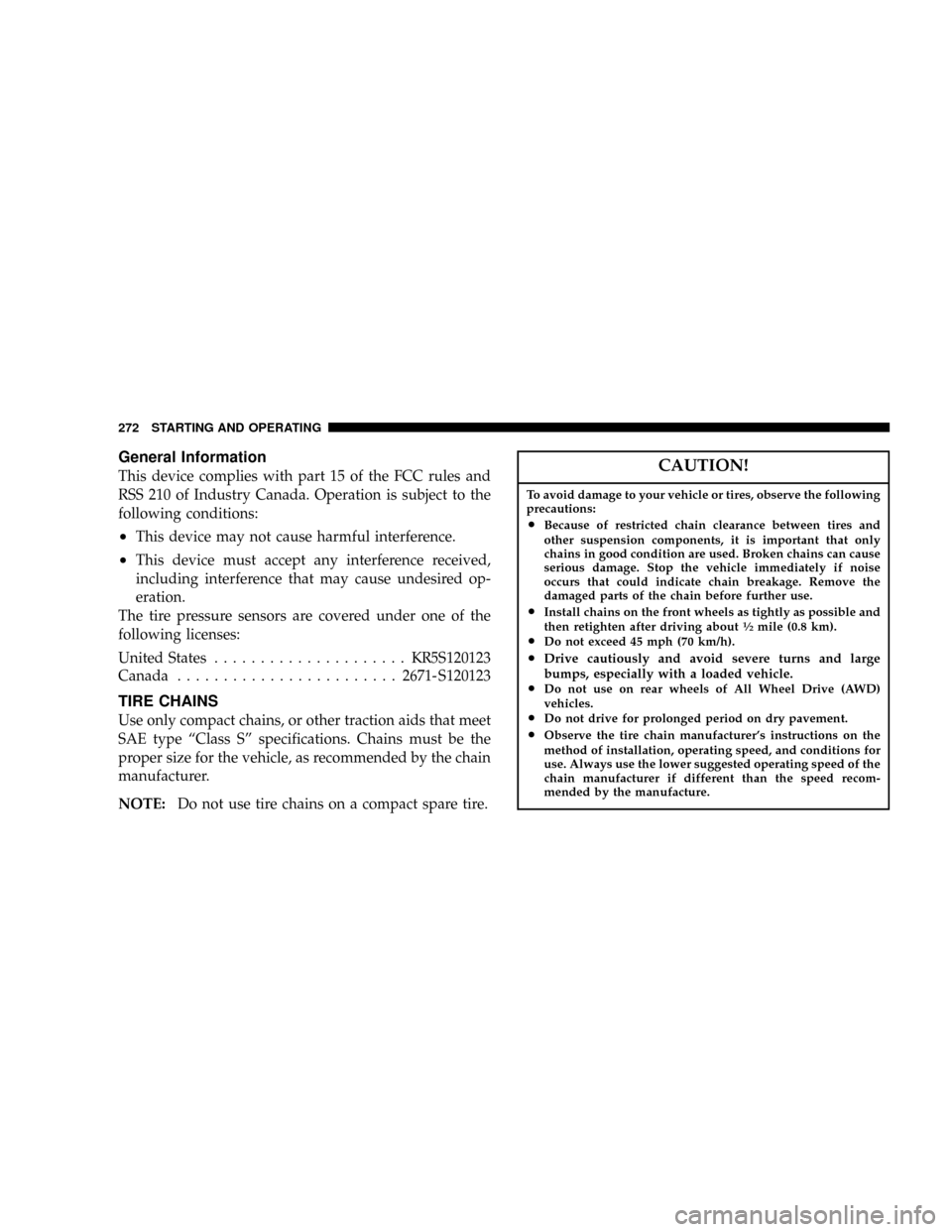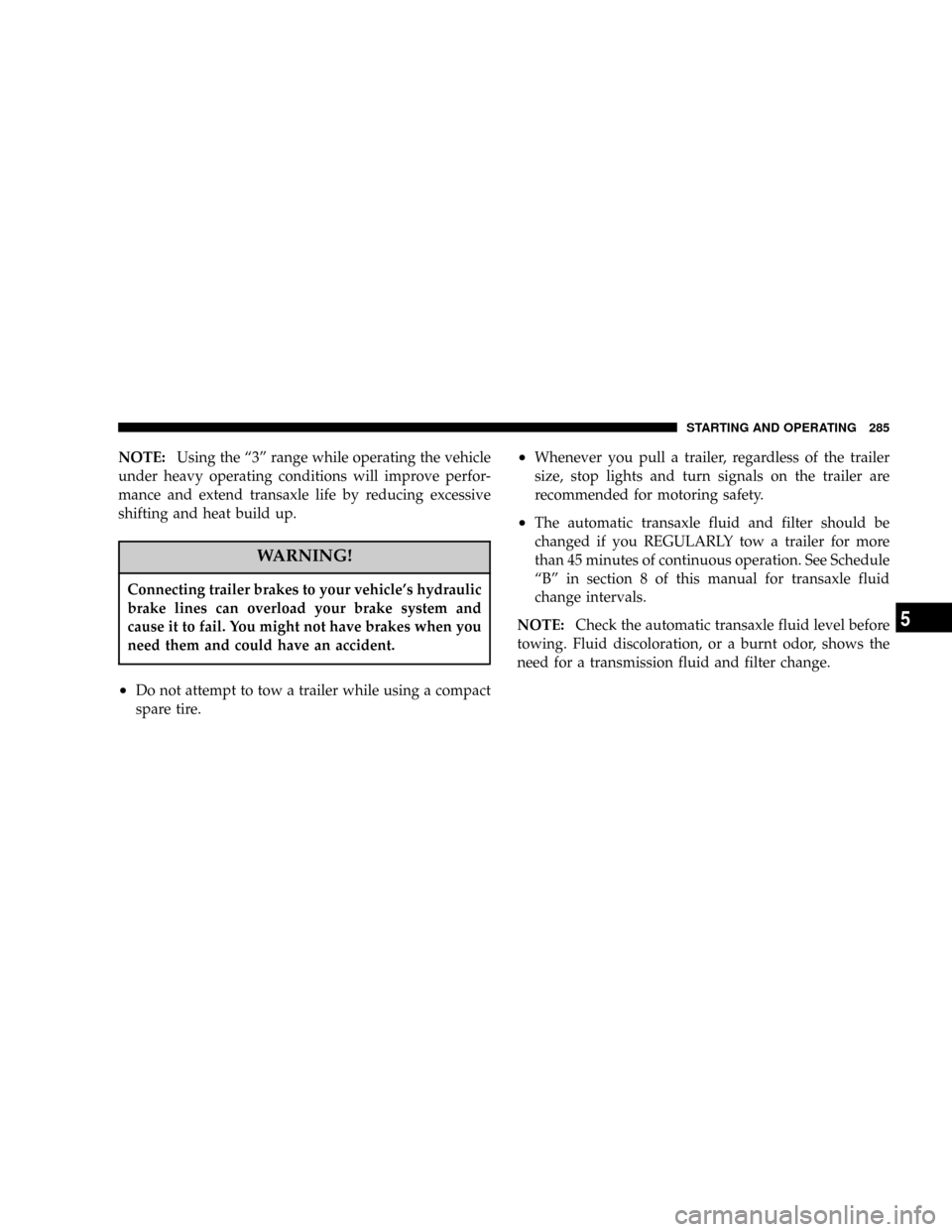Page 265 of 401
Do not install a wheel cover or attempt to mount a
conventional tire on the compact spare wheel, since the
wheel is designed specifically for the compact spare.
CAUTION!
Because of the reduced ground clearance, do not take
your vehicle through an automatic car wash with the
compact spare installed. Damage to the vehicle may
result.
Tire Spinning
When stuck in mud, sand, snow, or ice conditions, do not
spin your vehicle's wheels above 35 mph (55 km/h).
See the paragraph on Freeing A Stuck Vehicle in Section
6 of this manual.
WARNING!
Fast spinning tires can be dangerous. Forces gener-
ated by excessive wheel speeds may cause tire dam-
age or failure. A tire could explode and injure
someone. Do not spin your vehicle's wheels faster
than 35 mph (55km/h) when you are stuck. And don't
let anyone near a spinning wheel, no matter what the
speed.
STARTING AND OPERATING 265
5
Page 268 of 401

Improper alignment will not cause vehicle vibration.
Vibration may be a result of tire and wheel out-of-
balance. Proper balancing will reduce vibration and
avoid tire cupping and spotty wear.
ALL WHEEL DRIVE (AWD) Ð IF EQUIPPED
CAUTION!
All Wheel Drive (AWD) vehicles must have the same
size and type tires on all wheel positions. Unequal
tire sizes must not be used. Unequal tire size may
cause failure of the power transfer unit and/or the
viscous coupling.
TIRE PRESSURE MONITOR SYSTEM Ð IF
EQUIPPED
The Tire Pressure Monitor System (TPM) system uses
wireless technology with wheel rim mounted electronic
sensors to monitor tire pressure levels (EXCLUDING
THE SPARE TIRE). Sensors, mounted to each wheel as
part of the valve stem, transmit tire pressure readings to
a receiver located in the overhead console.
NOTE:The tire pressure monitoring system on your
vehicle will warn you when one of your tires is signifi-
cantly underinflated and when some combinations of
your tires are significantly underinflated. However, there
are other combinations of significantly underinflated
tires for which your tire pressure monitoring system may
not warn you. These other combinations are relatively
common, accounting for approximately half the instances
in which vehicles have significantly underinflated tires.
For example, your system may not warn you when both
tires on the same side or on the same axle of your vehicle
268 STARTING AND OPERATING
Page 270 of 401

TIRE PRESSURE NOW AVAILABLE
The TPM system is functioning normally and the external
interference is no longer affecting the system.
SPARE TIRE IN USE? YES/NO
The TPM system requires more information to determine
the correct mode of operation, one or more of the vehicle
active tires has been replaced by the spare, a wheel rim
not equipped with a TPM sensor or the TPM system
requires service.
If the spare tire or non TPM sensor equipped wheel rim
is in active use (mounted on the vehicle), answer YES and
the TPM system will resume normal operation.
If the spare tire or non TPM sensor equipped wheel rim
isNOTin active use (mounted on the vehicle), answer
NO and the TPM system will resume normal operation.
ALL 5 TIRES WITH CAR? YES/NO
The TPM system requires more information to determine
the correct mode of operation, one or more of the vehicle
active tires has been replaced by the spare, a wheel rim
not equipped with a TPM sensor or the TPM system
requires service.
If the spare tire or non TPM sensor equipped wheel rim
is in active use (mounted on the vehicle), answer YES and
the TPM system will resume normal operation.
If the spare tire or non TPM sensor equipped wheel rim
isNOTin active use (mounted on the vehicle), answer
NO and the TPM system will resume normal operation.
270 STARTING AND OPERATING
Page 272 of 401

General Information
This device complies with part 15 of the FCC rules and
RSS 210 of Industry Canada. Operation is subject to the
following conditions:
²This device may not cause harmful interference.
²This device must accept any interference received,
including interference that may cause undesired op-
eration.
The tire pressure sensors are covered under one of the
following licenses:
United States.....................KR5S120123
Canada........................2671-S120123
TIRE CHAINS
Use only compact chains, or other traction aids that meet
SAE type ªClass Sº specifications. Chains must be the
proper size for the vehicle, as recommended by the chain
manufacturer.
NOTE:Do not use tire chains on a compact spare tire.
CAUTION!
To avoid damage to your vehicle or tires, observe the following
precautions:
²Because of restricted chain clearance between tires and
other suspension components, it is important that only
chains in good condition are used. Broken chains can cause
serious damage. Stop the vehicle immediately if noise
occurs that could indicate chain breakage. Remove the
damaged parts of the chain before further use.
²Install chains on the front wheels as tightly as possible and
then retighten after driving about1¤2mile (0.8 km).²Do not exceed 45 mph (70 km/h).
²Drive cautiously and avoid severe turns and large
bumps, especially with a loaded vehicle.
²Do not use on rear wheels of All Wheel Drive (AWD)
vehicles.
²Do not drive for prolonged period on dry pavement.
²Observe the tire chain manufacturer's instructions on the
method of installation, operating speed, and conditions for
use. Always use the lower suggested operating speed of the
chain manufacturer if different than the speed recom-
mended by the manufacture.
272 STARTING AND OPERATING
Page 285 of 401

NOTE:Using the ª3º range while operating the vehicle
under heavy operating conditions will improve perfor-
mance and extend transaxle life by reducing excessive
shifting and heat build up.
WARNING!
Connecting trailer brakes to your vehicle's hydraulic
brake lines can overload your brake system and
cause it to fail. You might not have brakes when you
need them and could have an accident.
²Do not attempt to tow a trailer while using a compact
spare tire.
²Whenever you pull a trailer, regardless of the trailer
size, stop lights and turn signals on the trailer are
recommended for motoring safety.
²The automatic transaxle fluid and filter should be
changed if you REGULARLY tow a trailer for more
than 45 minutes of continuous operation. See Schedule
ªBº in section 8 of this manual for transaxle fluid
change intervals.
NOTE:Check the automatic transaxle fluid level before
towing. Fluid discoloration, or a burnt odor, shows the
need for a transmission fluid and filter change.
STARTING AND OPERATING 285
5
Page 289 of 401
WHAT TO DO IN EMERGENCIES
CONTENTS
mHazard Warning Flasher..................290
mIf Your Engine Overheats.................291
mJacking And Tire Changing................292
NJack Location........................293
NSpare Tire Stowage....................293
NPreparations For Jacking................294
NJacking Instructions....................295
mJump-Starting Procedures If Battery Is Low....298
mDriving On Slippery Surfaces..............299
NAcceleration.........................299NTraction............................300
mFreeing A Stuck Vehicle..................300
mTowing A Disabled Vehicle................301
NWith Ignition Key.....................301
NWithout The Ignition Key...............302
NTowing This Vehicle Behind Another Vehicle
(Flat Towing With All Four Wheels On The
Ground)............................302
NTowing This Vehicle Behind Another Vehicle
With A Tow Dolley....................303
6
Page 293 of 401
Jack Location
The jack and jack-handle are stowed behind the rear left
side trim panel in the cargo area. Pull up on the lever to
release the cover.
Spare Tire Stowage
The spare tire is stowed under the rear of the vehicle by
means of a cable winch mechanism. To remove or stow
the spare, use the jack handle to rotate the ªspare tire
driveº nut. The nut is located under the plastic cover at
the center-rear of the cargo floor area, just inside the
liftgate opening.
WHAT TO DO IN EMERGENCIES 293
6
Page 294 of 401
Spare Tire Removal
Fit the jack-handle over the drive nut. Rotate the nut to
the left until the spare is on the ground with enough slack
cable to allow you to pull the tire out from under the
vehicle.
CAUTION!
The winch mechanism is designed for use with the
jack handle only. Use of an air wrench or other
power tools is not recommended and can damage the
winch.
When the spare is clear, tilt the retainer at the end of the
cable and pull it through the center of the wheel.
Preparations For Jacking
Park the vehicle on a firm level surface, avoid ice or
slippery areas,set the parking brakeand place the gear
selector in PARK. Turn OFF the ignition.
WARNING!
Do not attempt to change a tire on the side of the
vehicle close to moving traffic. Pull far enough off
the road to avoid the danger of being hit when
operating the jack or changing the wheel.
294 WHAT TO DO IN EMERGENCIES